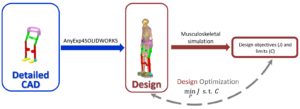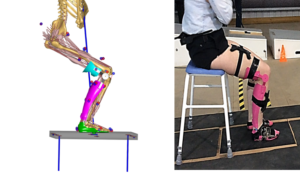Update from MovAiD Work Packages August 2017
WP4 MovAiD Computational Design
There are very few studies on the impact of mechanical design on the human body. WP4 Project partner, AnyBody Technology (ABT) has begun a design optimization framework for Movement Assistive Devices (MADs) (see figure 1), including an example for the knee ankle foot orthosis (KAFO) (see figure 2).
In Figure 1, J is the set of objectives, C is a set of constraints, and P is the vector of design parameters of interest. Depending on the phase of the design, conceptual or detailed, the blue part can be excluded or included, respectively.

Figure 1) MAD design optimization framework

Figure 2) (a) Integrated KAFO CAD model—exported through AnyExp4SOLIDWORKS– with a musculoskeletal model in AnyBody and (b) Experimental set up for sit-to-stand task
In the KAFO study, which was presented at the WearRAcon 2017 congress and is explained in ABT’s webcast, the design optimization objectives show how metabolic cost and knee reaction load is minimized to find the optimal stiffness at the KAFO knee joint within a sit-to-stand movement.
These simulation pipelines help to design and evaluate MADs by considering various physiological performance metrics, and enabling engineers to create devices that achieve multiple design objectives.
Watch the recording of ABT’s webcast.

